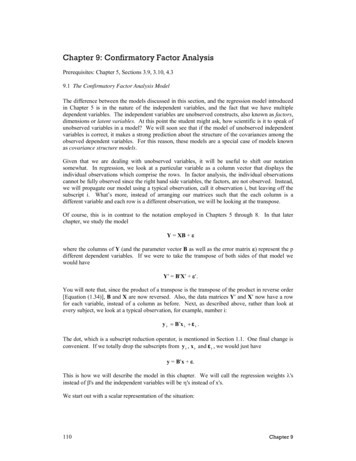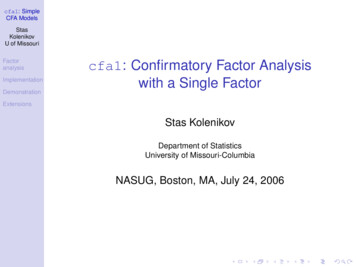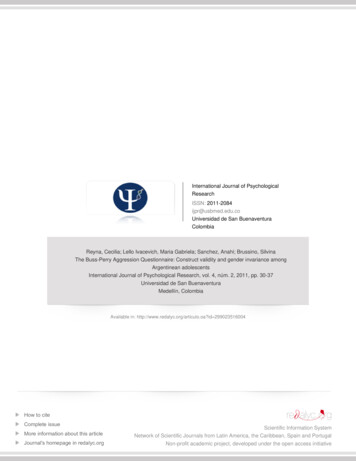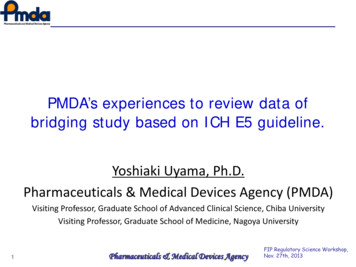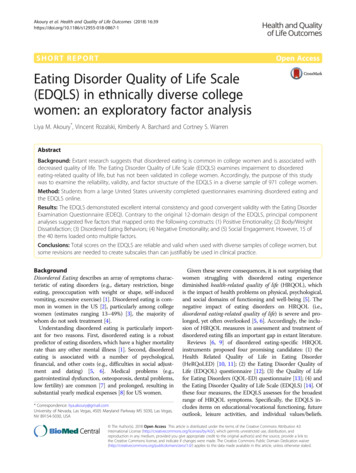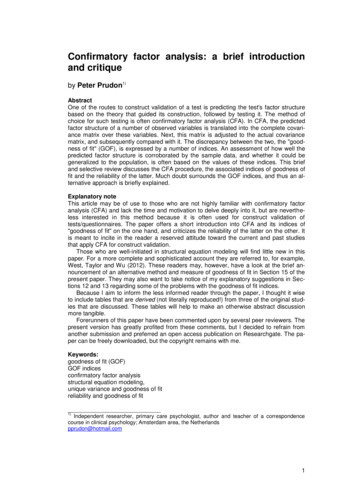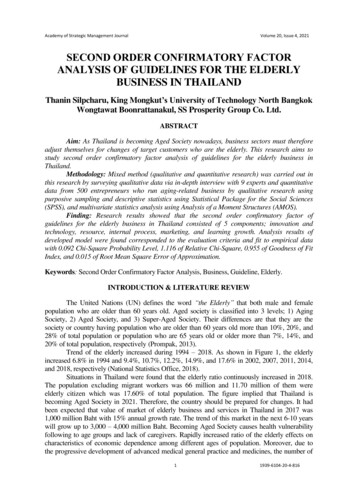
Transcription
Academy of Strategic Management JournalVolume 20, Issue 4, 2021SECOND ORDER CONFIRMATORY FACTORANALYSIS OF GUIDELINES FOR THE ELDERLYBUSINESS IN THAILANDThanin Silpcharu, King Mongkut’s University of Technology North BangkokWongtawat Boonrattanakul, SS Prosperity Group Co. Ltd.ABSTRACTAim: As Thailand is becoming Aged Society nowadays, business sectors must thereforeadjust themselves for changes of target customers who are the elderly. This research aims tostudy second order confirmatory factor analysis of guidelines for the elderly business inThailand.Methodology: Mixed method (qualitative and quantitative research) was carried out inthis research by surveying qualitative data via in-depth interview with 9 experts and quantitativedata from 500 entrepreneurs who run aging-related business by qualitative research usingpurposive sampling and descriptive statistics using Statistical Package for the Social Sciences(SPSS), and multivariate statistics analysis using Analysis of a Moment Structures (AMOS).Finding: Research results showed that the second order confirmatory factor ofguidelines for the elderly business in Thailand consisted of 5 components; innovation andtechnology, resource, internal process, marketing, and learning growth. Analysis results ofdeveloped model were found corresponded to the evaluation criteria and fit to empirical datawith 0.092 Chi-Square Probability Level, 1.116 of Relative Chi-Square, 0.955 of Goodness of FitIndex, and 0.015 of Root Mean Square Error of Approximation.Keywords: Second Order Confirmatory Factor Analysis, Business, Guideline, Elderly.INTRODUCTION & LITERATURE REVIEWThe United Nations (UN) defines the word “the Elderly” that both male and femalepopulation who are older than 60 years old. Aged society is classified into 3 levels; 1) AgingSociety, 2) Aged Society, and 3) Super-Aged Society. Their differences are that they are thesociety or country having population who are older than 60 years old more than 10%, 20%, and28% of total population or population who are 65 years old or older more than 7%, 14%, and20% of total population, respectively (Prompak, 2013).Trend of the elderly increased during 1994 – 2018. As shown in Figure 1, the elderlyincreased 6.8% in 1994 and 9.4%, 10.7%, 12.2%, 14.9%, and 17.6% in 2002, 2007, 2011, 2014,and 2018, respectively (National Statistics Office, 2018).Situations in Thailand were found that the elderly ratio continuously increased in 2018.The population excluding migrant workers was 66 million and 11.70 million of them wereelderly citizen which was 17.60% of total population. The figure implied that Thailand isbecoming Aged Society in 2021. Therefore, the country should be prepared for changes. It hadbeen expected that value of market of elderly business and services in Thailand in 2017 was1,000 million Baht with 15% annual growth rate. The trend of this market in the next 6-10 yearswill grow up to 3,000 – 4,000 million Baht. Becoming Aged Society causes health vulnerabilityfollowing to age groups and lack of caregivers. Rapidly increased ratio of the elderly effects oncharacteristics of economic dependence among different ages of population. Moreover, due tothe progressive development of advanced medical general practice and medicines, the number of11939-6104-20-4-816
Academy of Strategic Management JournalVolume 20, Issue 4, 2021death rates is reduced with better life quality and longer life span. In spite of longer life, physicalfitness is getting worse. Accident is easy to take place. Sickness from non-communicablediseases appears. Disability might be found and causes self-incapability (Srisuk, 2018).According to the population structural changes, unavoidable impact on economy and society arecertainly met. Having high ratio of the elderly in a country also reflect the lower number oflabors. These effects on national potential of products and services production. In addition, thegovernment has burden and expenses on welfare for the elderly and this might affect on financialstatus of the country (Thailand Development Research Institute, 2017).Note: The elderly rate means ratio of the aging per 100 populationFIGURE 1NUMBER AND RATIO OF THE ELDERLY DURING 1994-2018According to such problems, future situation should be greatly focused and will affect onnational economic and social systems. It is urgent to plan and be prepared for being aged societyso that the higher number of the elderly will have good life quality. Industrial business sectorshould be ready for elderly market in order to manufacture products and provide services thatmeet fundamental needs according to elderly groups and create new innovation and technology.This is considered great business opportunity to best enhance products and services for the aginggroup. Therefore, guidelines for the elderly business in Thailand to increase competitivepotential for industrial business sectors need to be studied.Innovation & TechnologyThe study of Kale (2017) showed 2 sources of innovation and technology for business;1) internal discovery for new concepts of products and services is often carried out byestablishing Research and Development (R&D) agencies and finding people who are talented inthinking of new things which might be the development of new products and services for addedvalue., and 2) knowledge sharing and getting external or open innovation; good concepts do nothave to only come from internal personnel. It is to accept new external ideas leading to morerapid and diverse ideas including lower costs and expenses than self-development as the expertswho are specifically specialized might be scattered outside the organization.21939-6104-20-4-816
Academy of Strategic Management JournalVolume 20, Issue 4, 2021MarketingThe study of Lies (2019) and the research of “Digital Marketing Techniques on TheirWay to Becoming Social Engineering Techniques in Marketing” from International Journal ofInteractive Multimedia and Artificial Intelligence explained customer’s true behaviors whichchange rapidly. High marketing competition is such an important factor that entrepreneurs mustadjust their marketing strategies. To succeed in marketing in digital society 5.0 corresponding toconsumer’s behaviors, 3 key strategies, heart of marketing 5.0, are needed; Conversion,Experience, and Data.Internal ProcessMclvor (2016) mentioned that significance of internal process is internal processimprovement or development, correction, and change for better internal process by discoveringcauses, analyzing, finding solution, including setting up work practice or manual to be goodwork standards. Meaning of internal process improvement or the manual is always reviewedwhen a problem is found. The internal process improvement will be able to lessen internalconflicts between departments including internal and external customer’s complaints.Learning and GrowthThe research of Karlinsky-Shichor and Zviran, M. (2016) on knowledge management(KM) and its framework was carried out by having literature review about development ofconcepts of knowledge management and showing KM elements for establishing a system. The 3KM elements are KM resource, KM activities, and KM impact. Its collaborative framework canbe achieved from the results of expert, academician, and entrepreneur’s opinions, reviews, andsuggestions. KM must rely on 3 key components; 1) human or personnel; It is the mostimportant factor for KM operation. Human is the most significant knowledge source and the onewho applies all knowledge for organizational development., 2) technology; It is an assistant forsearching, sharing, and collecting data and allows people to rapidly and conveniently apply suchdata for organizational development., and 3) KM process; In every KM process equally andefficiently relates among one another.ResourcesThe study of Jensen et al. (2016): World Academy of Science, Engineering andTechnology on The Resource-Base View of Organization and Innovation: Recognition ofSignificant Relationship in an Organization was about strategic management by showing therelationship between organizational resource and innovation. Resource drives organizationalcapacity which leads to innovation ability and achievement according to suitable guidelines.Resource is strength of the organization and significantly effect on competitiveness. It consists of4 attributes; valuable resource, rare resource, imperfectly imitable resource, and nonsubstitutable resource.Second-order Confirmatory Factor Analysis (SCFA)A multiple statistical method starting from Exploratory Factor Analysis (EFA) whichgroups highly-related variables in the same group and verifies them by using ConfirmatoryFactor Analysis (CFA) to confirm grouping correctness between observative variables and eachlatent variable. After that, the variable will be re-verified in order to confirm the correctness ofeach latent variable whether it suits for the research or not (Silpcharu, 2020).31939-6104-20-4-816
Academy of Strategic Management JournalVolume 20, Issue 4, 2021ObjectivesObjective of this study is to analyze components of second-order confirmatory factor ofguidelines for the elderly business in Thailand.METHODOLOGY1.2.3.4.Qualitative research using in-depth interview technique; 9 experts were the population of this research.Purposive sampling was used by determining qualification of experts. The experts were thereforedivided into 3 groups; 3 experts in a group of entrepreneur or executives in business organizations, 3experts in a group of elderly-related public sectors or agencies, and 3 experts in a group ofacademicians. Data were collected for setting a questionnaire.Quantitative research; Population of this research is executives or owners of active commerceregistered business according to Business Registration Act. 272,803 elderly-related businesses(Department of Business Development Ministry of Commerce, 2019) are classified following tobusiness categories by using criteria of component analysis research. 500 samples were determined invery good level (Silpcharu, 2020) Multistage sampling was used and consisted of cluster sampling with2 groups of business categories; service business and non-service business. Probability sampling wasthen used for collecting data from the sample groups (Silpcharu, 2020).A tool for component analysis research was a 100-question rating-scale questionnaire bydetermining weighing criteria into 5 scales of Likert (David & Sutton, 2011). Test results of toolquality showed 0.60-1.00 Index of Item Objective Congruence: IOC, 0.31 – 0.78 Corrected Item–Total Correlation by individually analyzing discrimination value, and 0.973 Cronbach’ AlphaCoefficient from content validity analysis.Data collection in this research was carried out by interviewing the sample groups. Descriptivestatistics using SPSS and Multivariate Statistical Analysis using AMOS were used for dataanalysis with the 4 following values for evaluating the data-model fit; 1) Chi-square ProbabilityLevel was more than 0.05., 2) Relative Chi-square was less than 2.00., 3) Goodness of Fit Indexwas greater than 0.90., and 4) Root Mean Square Error of Approximation was less than 0.08(Silpcharu, 2020).RESULTSAnalysis results of second-order confirmatory factor analysis of guidelines for the elderlybusiness in Thailand are as shown in Figure 2.According to Figure 2, it showed statistical values evaluating the fit of post-improvementsecond-order confirmatory factor analysis model of guidelines for the elderly business inThailand by considering Modification Indices (MI) according to the study of Arbuckle. It wasfound that Chi-Square probability level (CMIN-P) value equaled to 0.092 which was greater than0.05. Relative Chi-Square (CMIN/DF) was 1.116 which was less than 2. Goodness of Fit Index(GFI) was 0.955 which was greater than 0.90 and Root Mean Square Error of Approximation(RMSEA) was 0.015 which was less than 0.08. These can be concluded that all 4 statisticalvalues were qualified. Therefore, the second-order confirmatory factor analysis model ofguidelines for the elderly business in Thailand was fit to the empirical data.Guidelines for the elderly business in Thailand consisted of 5 latent variables whichcould be ascendingly prioritized according to its weight as follows; 1) Internal Process;Regression Weight 0.98, R2 0.96, 2) Resources; Regression Weight 0.95, R2 0.91, 3)Innovation & Technology; Regression Weight 0.89, R2 0.79, 4) Marketing; RegressionWeight 0.86, R2 0.74, and 5) Learning & Growth; Regression Weight 0.76, R2 0.58.41939-6104-20-4-816
Academy of Strategic Management JournalVolume 20, Issue 4, 2021FIGURE 2SECOND-ORDER CONFIRMATORY FACTOR ANALYSIS OF GUIDELINES FORELDERLY BUSINESS IN THAILANDAnalysis results of levels of significance of post-improvement second-orderconfirmatory factor analysis model of guidelines for the elderly business in Thailand showedmean and Standard Deviation (S.D.) values of each component as shown in Table 1.According to Table 1, it was found that overall significance of guidelines for theelderly business in Thailand was high with 4.18 mean values. Considered individually,significance of all components was high. The significance of innovation and technology,internal process, marketing, resource, and learning and growth was 4.24, 4.23, 4.22, 4.17 and4.05, respectively. Individual analysis results of levels of significance of second-orderconfirmatory factor of guidelines for the elderly business in Thailand. Significance ofindividual analysis results was high with 3.98 – 4.33 mean value and the top 3 componentscould be ascending put in order as follows:i.ii.iii.Innovation & Technology; 1) focuses on innovation development by teamwork, 2) collaborates withpublic sector, research networks, and educational institutes to discover new innovation and technology,and 3) keeps up with innovation idea to make it become concrete benefit with 4.33, 4.24, and 4.21mean values, respectively.Resource; 1) regularly evaluates tool, machine, and equipment suitability to consider making decisionin buying or improving them, 2) provides experts in elderly psychology, and 3) uses internal andexternal information for analysis and decision making with 4.19, 4.19, 4.07 mean values, respectively.Internal process; 1) collaborates with external organizations to set up elderly-related businessplatforms, 2) determines departments/units/divisions/personnel to be responsible for products or51939-6104-20-4-816
Academy of Strategic Management Journaliv.v.Volume 20, Issue 4, 2021services specifically for the elderly, and 3) coordinates with all sector to have consistent work operationto mutual goal with 4.28, 4.27, and 4.19 mean values, respectively.Marketing; 1) never takes advantage from setting exaggerated price of elderly-related products, 2) setsthe price by considering worthiness because the elderly has financial restrictions, and 3) establishesagencies for product and service demonstration at user’s place with 4.25, 4.24, and 4.17 mean values,respectively.Learning and Growth; 1) sets up human networks who experiences from actual practices, 2) providesmanner training course for personnel in the organization, and 3) clearly determines goals of knowledgesharing and relate them to business goals with 4.13, 4.09, and 4.05 mean values, respectively.Table 1MEAN AND STANDARD DEVIATION (S.D.) VALUES OF GUIDELINES FOR ELDERLY BUSINESSIN THAILANDGuidelines for Elderly Business in ThailandS.D.OVERALL GUIDELINE FOR ELDERLY BUSINESS4.180.361. INNOVATION & TECHNOLOGY4.240.40Design products or services by considering independent elderly’s selfINNT14.180.63assistanceINNT6Focus on innovation development by teamwork4.330.65Allocate time for personnel in the organization to create and develop productsINNT94.210.71or services for elderlyINNT11Keep up with innovation idea to make it become concrete benefit4.210.70Collaborate with public sector, research networks, and educational institutes toINNT184.240.59discover new innovation and technology2. RESOURCES4.170.42RE2Provide experts in elderly psychology4.190.72Develop purchase system in order to obtain qualified raw materials for productRE114.070.75or service productionRegularly evaluate tool, machine, and equipment suitability to consider makingRE144.190.67decision in buying or improving themRE17Use internal and external information for analysis and decision making4.070.69Coordinate with external organizations to co-use elderly-related big dataRE204.070.74together3. INTERNAL PROCESS4.230.39Set Cross-functional team collaboration in the organization to develop productsINP44.170.68and services to fit the elderly in each age gapINP6Determine short-term and long-term plan to support elderly-related business4.150.71INP10Coordinate with all sector to have consistent work operation to mutual goal4.190.67Collaborate with external organizations to set up elderly-related businessINP124.280.63platformsDetermine departments/units/divisions/personnel to be responsible for productsINP184.270.68or services specifically for the elderly4. MARKETING4.220.38Set the price by considering worthiness because the elderly has financialMKT74.240.63restrictionsNever take advantage from setting exaggerated price of elderly-relatedMKT84.250.64productsMKT9Apply quantitative discount policy for big order of products or services4.170.70MKT10Establish agencies for product and service demonstration at user’s place4.170.68Analyze internal and external situations to adjust strategies in design planningMKT194.070.78and products or services production5. LEARNING & GROWTH4.050.48LG6Clearly determine goals of knowledge sharing and relate them to business goals 4.050.71LG8Set up human networks who experiences from actual practices4.130.70LG12Provide manner training course for personnel in the organization4.090.74Provide training courses for knowledge and ability development to apply inLG174.020.76organizational developmentLG20Create culture of learning organization to urge everyone’s creativity3.980.8161939-6104-20-4-816
Academy of Strategic Management JournalVolume 20, Issue 4, 2021DISCUSSION1.2.3.The component most effecting on guidelines for the elderly business in Thailand is internal processwith 0.98 Standardized Regression Weight and 0.001 statistical significance. This is in accordance withperformance management. KPI is important for the operations of online stores who sell products forthe elderly. The Key Performance Indicator (KPI) from Balanced Scorecard (BSC) showed thatinternal process was in the first place, followed by learning and growth, customer, and finance,respectively (Tsai & Cheng, 2012).Innovation & Technology aspect of guidelines for the elderly business in Thailand was the mostsignificant component with 4.24 mean value. The figure reflects the importance of using innovationand technology as an important role of operation for the elderly business in Thailand in order to helpthe elderly who have poor health, stay independently, or sick by non-communicable disease to live welland happily. This was in accordance with the study of mHealth which showed that the rapidly highernumber of aging populations comes with chronic diseases. Therefore, there are a number of challengesto meet elderly group’s complicated requirement. mHealth mobile technology shows the determinationof elderly assistance to manage chronic diseases. Using mHealth technology to develop innovation ofelderly home health care (Matthew-Maich et al., 2016) and new value presentation lead to theadjustment of mutual understanding among relating people and the elderly such as the elderly andcaregivers so that they realize value of the robot that assists and helps the elderly. The robot might helpthe family member feel safe, however; the elderly might be stressed when they have to rely on thetechnology. This is therefore the obstacle of service acceptance (Čaić, 2018).Innovation development by teamwork was individually focused and the most significant with 4.33mean value. However, as the teams from diverse and various professions cooperate to developintegrated concept of innovation for responding the elderly’s complicated requirement from theories topractices by encouraging practitioners to change their vision and be the center of management andhelping them to develop their new roles and be able to share their knowledge among experts (deStampa, 2014).Suggestions for Further StudyAccording to second-order confirmatory factor analysis of guidelines for the elderlybusiness in Thailand, the author would like to suggest 3 issues of guidelines for the elderlybusiness as described below:1.2.3.Education; the government by Ministry of Education should provide learning plan and prepareelderly’s care procedure starting from childhood. Children should learn and understand the elderly,learn their restrictions, abilities, and physical fitness, and deeply reach their minds in order to live withthem happily. Moreover, the society must be campaigned and implanted with values of realization ofelderly’s value following to the culture focusing on gratitude. For working-age group, caregiver shouldhave knowledge and abilities to take care and live with the elderly happily. Elderly’s expense supportershould have financial and time plan to take care of their parents and even themselves in the future. Theelderly should be encouraged to learn technology and innovation which rapidly change so that they willbe able to accept and not refuse assistance from supporter or caregiver.Business entrepreneur; Business guidelines for the elderly are 1) focusing on innovation developmentby teamwork, 2) collaborating with external organizations to set up elderly-related business platforms,3) determining departments/units/divisions/personnel to be responsible for products or servicesspecifically for the elderly, 4) never taking advantage from setting exaggerated price of elderly-relatedproducts, and 5) collaborating with public sector, research networks, and educational institutes todiscover new innovation and technology. Therefore, the business entrepreneur should adjust theirbusiness operational plan to be more suitable for elderly services.Social development and human security; Public sectors should prepare the development of suitableenvironment and public services for the elderly’s lifestyle, the development of accommodationadjustment prototype so that the elderly or caregiver will be able to conveniently and safely utilize itand help the elderly to be able to live when they have to be alone., comprehensive, sufficient, andconvenient healthcare service so that the elderly are able to easily, conveniently and safely access to itwith qualified standards., financial planning and adequate saving for the elderly themselves and theiroffspring, the development for caretaker’s knowledge, and provision post-retired jobs both in publicand private sectors.71939-6104-20-4-816
Academy of Strategic Management JournalVolume 20, Issue 4, 2021REFERENCESČaić, M., Odekerken-Schröder, G., & Mahr, D. (2018). Service robots: value co-creation and co-destruction inelderly care networks. Journal of Service Management, 29 (2), 178-205.David, & Sutton. (2011). Social research: An introduction, 2nd ed. SAGE, London, UK: 259De Stampa, M., Vedel, I., Trouvé, H., Ankri, J., Saint Jean, O., & Somme, D. (2014). Multidisciplinary teams ofcase managers in the implementation of an innovative integrated services delivery for the elderly inFrance. BMC Health Services Research, 14(1), 1-8.Department of Business Development Ministry of Commerce. (2019). The Statistic of the Juristic Person'sRegistration in 2019. Retrieved from www.dbd.go.thJensen, J.A., Cobbs, J.B., & Turner, B.A. (2016). Evaluating sponsorship through the lens of the resource-basedview: The potential for sustained competitive advantage. Business Horizons, 59(2), 163-173.Kale, D. (2017). Sources of innovation and technology capability development in the Indian automobileindustry. Institutions and Economies, 121-150.Karlinsky-Shichor, Y., & Zviran, M. (2016). Factors influencing perceived benefits and user satisfaction inknowledge management systems. Information Systems Management, 33(1), 55-73.Lies, J. (2019). Marketing intelligence and big data: Digital marketing techniques on their way to becoming socialengineering techniques in marketing. International Journal of Interactive Multimedia & ArtificialIntelligence, 5(5).Matthew-Maich, N., Harris, L., Ploeg, J., Markle-Reid, M., Valaitis, R., Ibrahim, S., & Isaacs, S. (2016).Designing, implementing, and evaluating mobile health technologies for managing chronic conditionsin older adults: a scoping review. JMIR mHealth and uHealth, 4(2), e29McIvor, R. (2016). An analysis of the application of process improvement techniques in business processoutsourcing. International Journal of Quality & Reliability Management, 33(3), 321-343.National Statistical Office Thailand. (2018). The Report on the 2018 survey of older person in Thailand,Statistical Forecasting Division National Statistical Office.Prompak, C. (2013). Aging Society in Thailand. Bureau of parliamentary studies of the secretariat of the senate.Silpcharu T. (2020). Research and Statistics Analysis by SPSS and AMOS. 18th edition, Nonthaburi : BusinessR&D Part., Limited.Srisuk, A. (2018). Lived experiences of sons being caregivers for dependent elderly parents.Thailand Development Research Institute. The estimated increasing cost of the elderly compared with governmentrevenue 2012 - 2021.Tsai, Y.C., & Cheng, Y.T. (2012). Analyzing key performance indicators (KPIs) for E-commerce and Internetmarketing of elderly products: A review. Archives of Gerontology and Geriatrics, 55(1), 126-132.81939-6104-20-4-816
Second-order Confirmatory Factor Analysis (SCFA) A multiple statistical method starting from Exploratory Factor Analysis (EFA) which groups highly-related variables in the same group and verifies them by using Confirmatory Factor Analysis (CFA) to confirm grouping correctness between observative variables and each latent variable.
